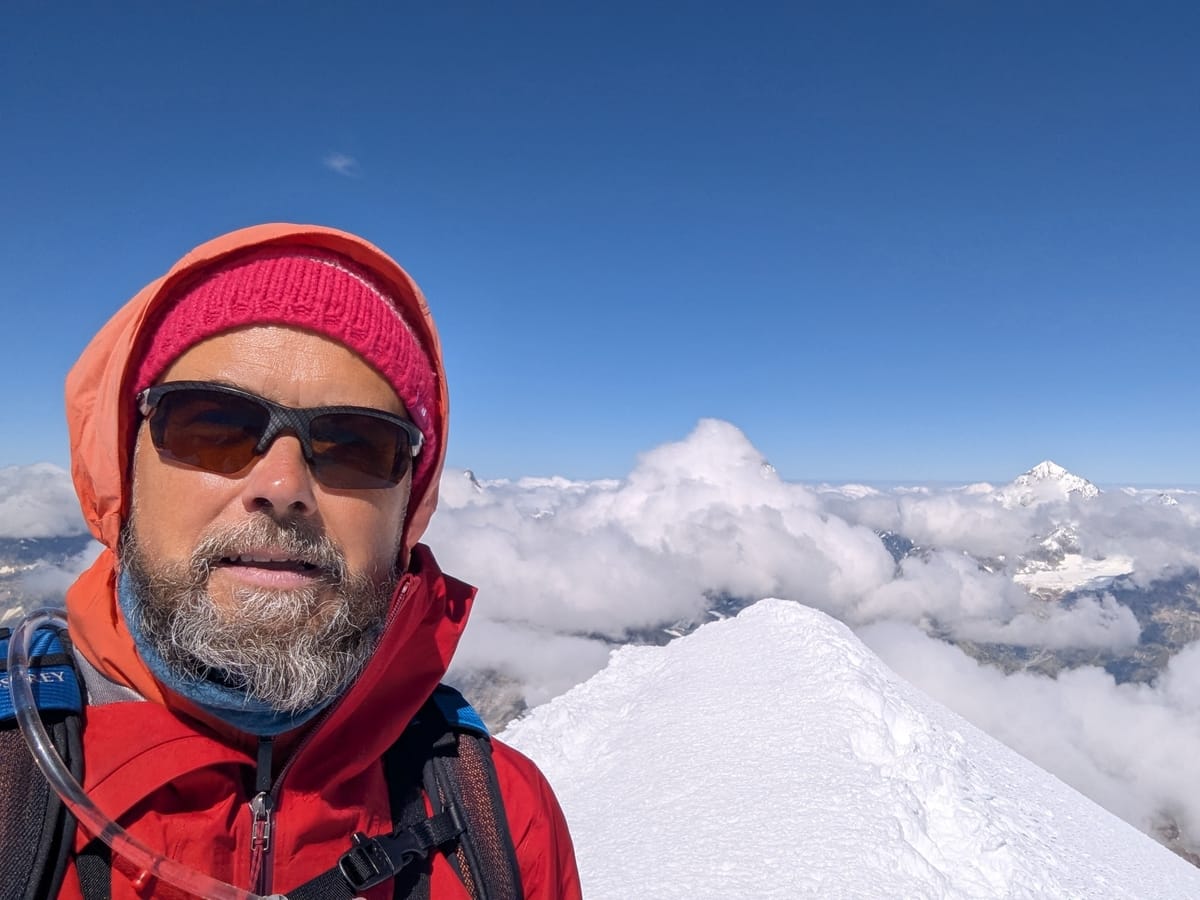
Western Breithorn summit (4164m), July 31, 2025: my seventh Alpine four-thousander. Matterhorn/Monte Cervino (in the clouds) and Dent Blanche in the background. Photo by Aki Kärkkäinen.
Would you share and hold a rope with your team? The answer to that question is a leading indicator of whether a team will succeed or fail. In mountaineering, being roped is a matter of survival. In business, it’s a metaphor for trust, alignment, and high performance.
I was reflecting on this as I joined a group of two clients and a mountain guide this summer to climb Breithorn. We’d never met before, we spoke different languages, but we had a common goal—and plenty of fun. At 4164 meters, roped together, I realized something: in just a few hours, we had transitioned from a group into a team.
The Rope of Trust: Distance vs Connection
What if there’s no physical rope? How do you hold it in distributed teams? How is distance defined anyway?
I’ve worked with co-located teams that might as well be on different planets, and distributed teams so aligned they finish each other’s sentences in Slack. The difference isn’t location—it’s whether you’d trust your teammate to hold the rope.
I’m reminded of the pandemic when social distancing was introduced—an unfortunate term, because what was meant was actually physical distancing. Most companies obsess over physical proximity when the real challenge is connection distance.
Being truly socially connected (roped) together depends on curiosity, accountability, motivated individuals, capability development, leadership, and strategy. Physical proximity may be a shortcut, but genuine connection is built through vulnerability, trust and shared purpose.
Climbing with AI?
So what does this mean in today’s AI-enhanced, multicultural, distributed world? What does being roped with an AI assistant or agent even look like?
In traditional rope teams, trust is built through shared risk and mutual dependence. But AI doesn’t fear falling. It doesn’t stumble. Its role is different: it amplifies human capability. That makes AI less of a rope partner and more of an essential tool you carry in your pack.
Still, tools require trust to a certain degree, too. Would you let an AI catch your error before it reaches production? Would you let it guide your next business decision? In that sense, we are tied to AI—just not in the same way we’re tied to people.
What Mountains Teach Leaders and Teams
On Breithorn, we achieved something together because we had:
- Trust & psychological safety
- Clear communication
- Shared understanding of risks
- The right skills and people
- An elevated goal
- An ability to adapt or pivot along the way
Mountains require you to be in the present moment. You can’t carry a huge backpack (or backlog!). You travel light, focus on essentials, monitor performance in real time, and adapt constantly to the environment based on feedback. Nice-to-haves disappear at altitude—prioritization becomes obvious.
The Agile Parallel
The mountain strips away pretense—just like good agile practices do. Unpredictability is ever present: you plan thoroughly then change the plan, making decisions with incomplete information. How you reach the goal is up to the team and the ever-changing system. You adapt, work around obstacles, or rewrite the rules based on your current capabilities.
When roped together, you move as one system. If I fall in a crevasse, you feel it immediately. If you need to slow down, I adapt my pace. There’s no hiding behind status reports or pretending everything’s fine when it isn’t. The rope creates radical transparency because survival depends on it.
Agile isn’t dead—it has retreated back to the mountains to forge a new strategy!
The Real Question
No, I’m not an expert alpinist—I’m a curious outdoor enthusiast exploring my limits. But I’ve spent enough time in the mountains to recognize similarities with working life. Experts like Amy C. Edmondson, Patrick Lencioni, J. Richard Hackman, Tom DeMarco, Jon R. Katzenbach, and many others have shaped my understanding of team dynamics and leadership.
So I’ll ask again: Do you want to share and hold a rope with your team?
Next time you’re working with your team—remote, hybrid, or AI-enhanced—ask yourself: are we truly roped together, or just walking side by side?
I dedicate this post to my mother and father who sadly suffer from Alzheimer’s disease and dementia. They turned 90 years old this summer ❤️
Lastly, a shout-out to all the teams I’ve been part of over the last 25 years—I couldn’t have written this without you 🙏